
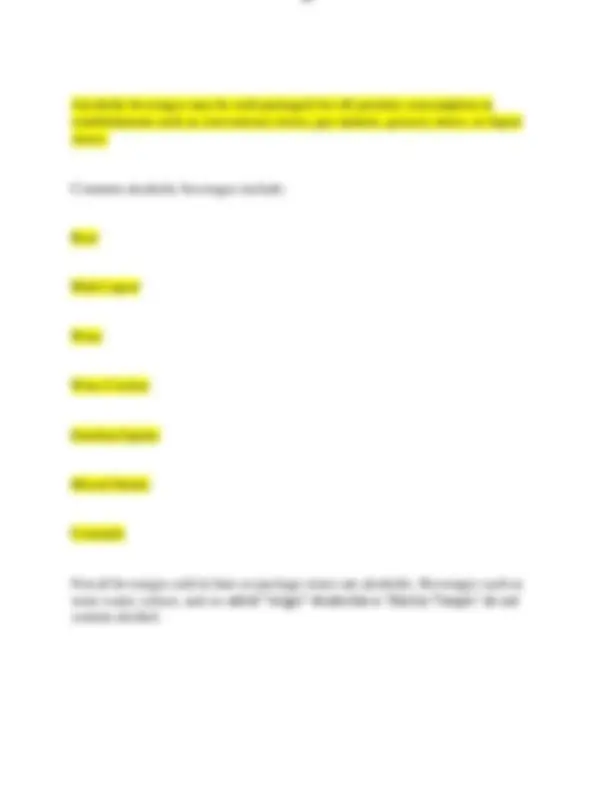
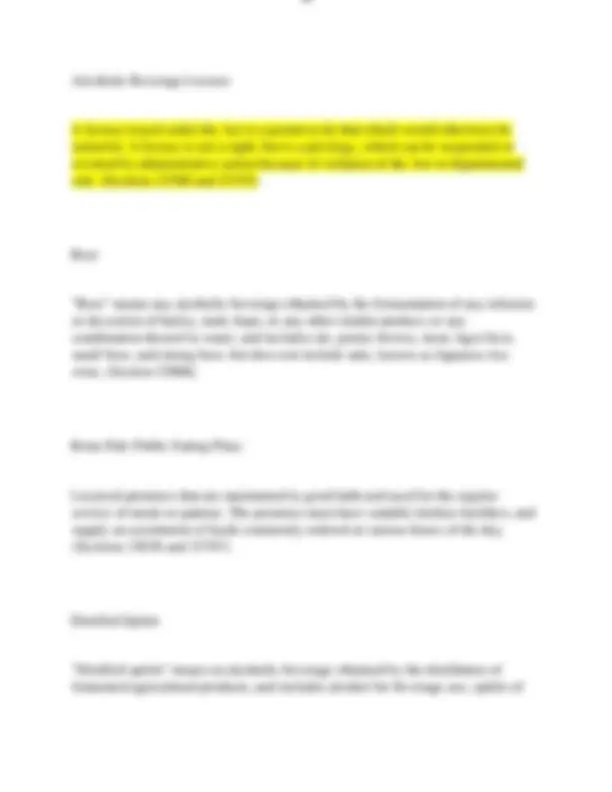
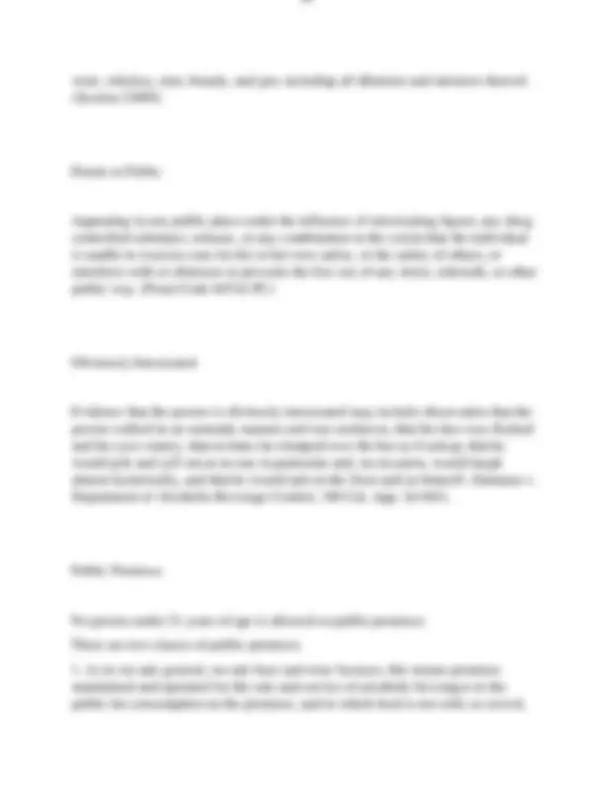
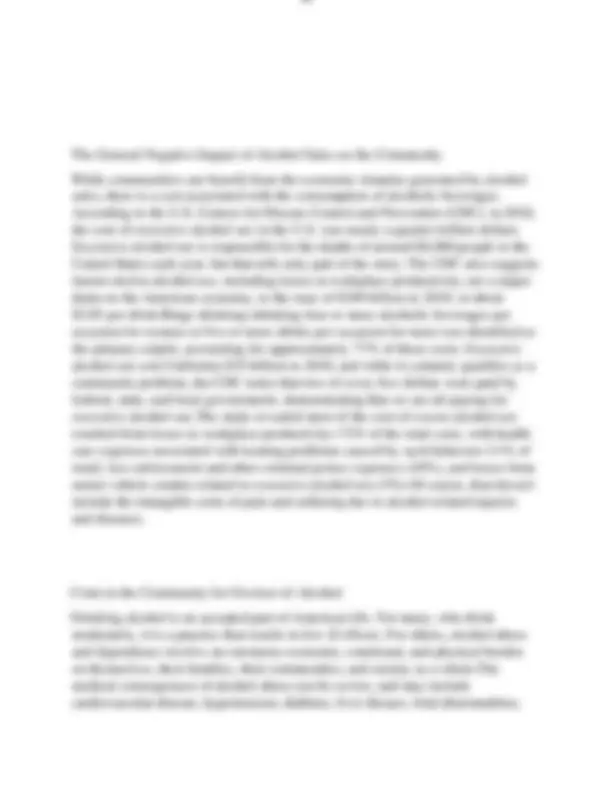
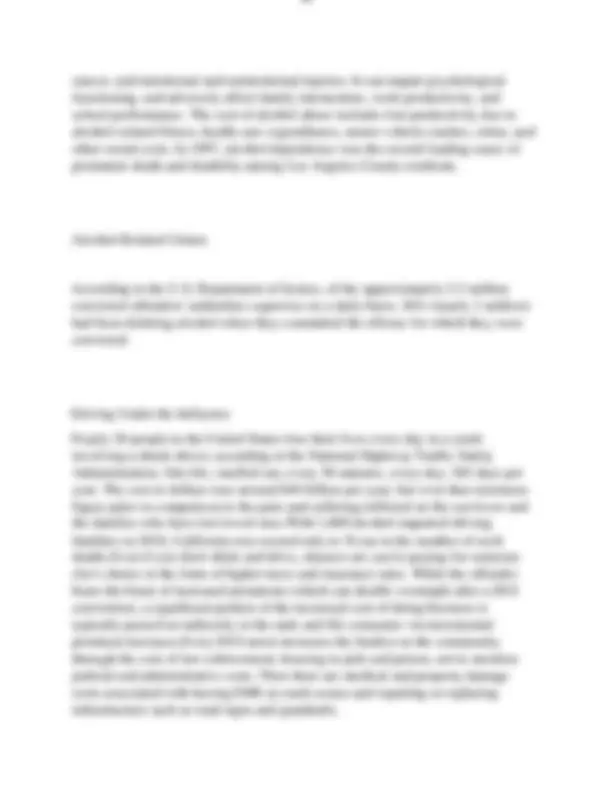
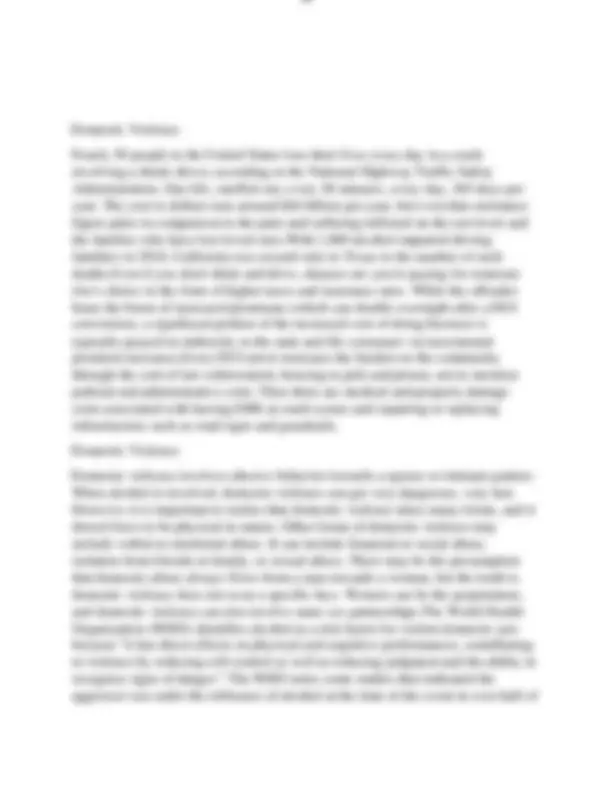
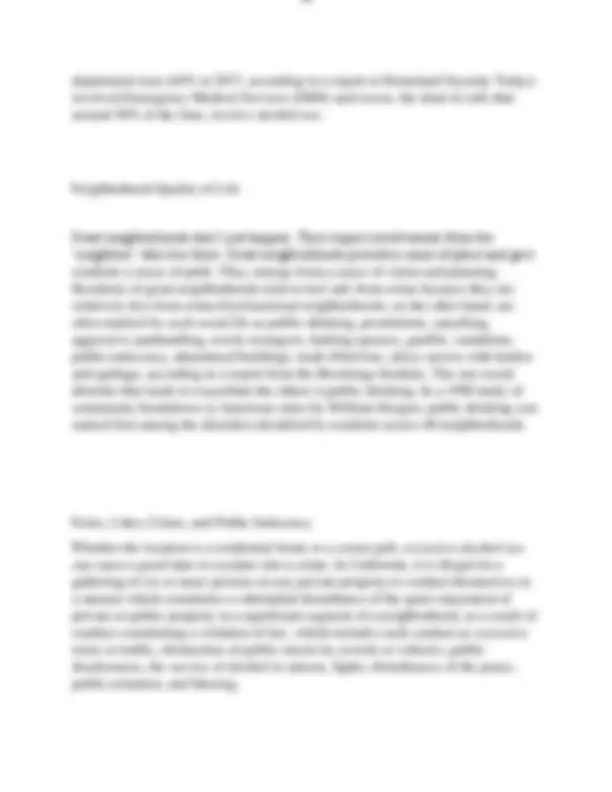



Study with the several resources on Docsity

Earn points by helping other students or get them with a premium plan


Prepare for your exams
Study with the several resources on Docsity

Earn points to download
Earn points by helping other students or get them with a premium plan
Community
Ask the community for help and clear up your study doubts
Discover the best universities in your country according to Docsity users
Free resources
Download our free guides on studying techniques, anxiety management strategies, and thesis advice from Docsity tutors
RBS CERT QUESTIONS AND ANSWERS WITH VERIFIED SOLUTIONS AND ANSWERS WITH VERIFIED SOLUTIONS 100% CORRECT (GRADED A+)
Typology: Exams
1 / 14

This page cannot be seen from the preview
Don't miss anything!









"ABC" means the Department of Alcoholic Beverage Control. ABC On-Premise License "ABC on-premises license" means an ABC license that grants the privilege to serve alcoholic beverages to patrons, who then consume them within the licensed premises. ABC On-Premise Licensee ABC on-premises licensee" means the owner of an ABC on-premise license. ABC Licensed Premises "ABC licensed premises" means a location where an ABC on-premises licens
Accreditation Agency A business entity the department has given the authority to approve RBS training courses, and training providers, according to the standards of the RBSTPA and Article 25 of TITLE 4. DEPARTMENT OF ALCOHOLIC BEVERAGE CONTROL PROPOSED REGULATIONS. Alcohol "Alcohol" means ethyl alcohol, hydrated oxide of ethyl, or spirits of wine, from whatever source or by whatever process produced. (Section 23003) Alcohol Server Certification Exam An exam given to alcohol servers after they complete a RBS training course to test the alcohol server's knowledge of the required curriculum. Alcoholic Beverage “Alcoholic beverage” includes alcohol, spirits, liquor, wine, beer, and every liquid or solid containing alcohol, spirits, wine, or beer, and which contains one-half of 1 percent or more of alcohol by volume, and which is fit for beverage purposes either alone, or when diluted, mixed, or combined with other substances. (Section
Alcoholic beverages may be sold by the drink for on-premise consumption in establishments such as restaurants and bars.
Alcoholic Beverage License A license issued under the Act is a permit to do that which would otherwise be unlawful. A license is not a right, but is a privilege, which can be suspended or revoked by administrative action because of violation of the Act or departmental rule. (Sections 23300 and 23355) Beer "Beer" means any alcoholic beverage obtained by the fermentation of any infusion or decoction of barley, malt, hops, or any other similar product, or any combination thereof in water, and includes ale, porter, brown, stout, lager beer, small beer, and strong beer, but does not include sake, known as Japanese rice wine. (Section 23006) Bona Fide Public Eating Place Licensed premises that are maintained in good faith and used for the regular service of meals to patrons. The premises must have suitable kitchen facilities, and supply an assortment of foods commonly ordered at various hours of the day. (Sections 23038 and 23787) Distilled Spirits "Distilled spirits" means an alcoholic beverage obtained by the distillation of fermented agricultural products, and includes alcohol for beverage use, spirits of
wine, whiskey, rum, brandy, and gin, including all dilutions and mixtures thereof. (Section 23005) Drunk in Public Appearing in any public place under the influence of intoxicating liquor, any drug, controlled substance, toluene, or any combination to the extent that the individual is unable to exercise care for his or her own safety, or the safety of others, or interferes with or obstructs or prevents the free use of any street, sidewalk, or other public way. (Penal Code 647(f) PC) Obviously Intoxicated Evidence that the person is obviously intoxicated may include observation that the person walked in an unsteady manner and was unshaven, that his face was flushed and his eyes watery, that at times he slumped over the bar as if asleep, that he would jerk and yell out at no one in particular and, on occasion, would laugh almost hysterically, and that he would spit on the floor and on himself. (Samaras v. Department of Alcoholic Beverage Control, 180 Cal. App. 2d 842). Public Premises No person under 21 years of age is allowed on public premises. There are two classes of public premises:
Performing any of the following actions by an alcohol server as an employee or contractor of an ABC on-premises licensee when interacting with a patron of the ABC licensed premises:
The General Negative Impact of Alcohol Sales on the Community While communities can benefit from the economic stimulus generated by alcohol sales, there is a cost associated with the consumption of alcoholic beverages. According to the U.S. Centers for Disease Control and Prevention (CDC), in 2010, the cost of excessive alcohol use in the U.S. was nearly a quarter trillion dollars. Excessive alcohol use is responsible for the deaths of around 88,000 people in the United States each year, but that tells only part of the story. The CDC also suggests factors tied to alcohol use, including losses in workplace productivity, are a major drain on the American economy, to the tune of $249 billion in 2010, or about $2.05 per drink.Binge drinking (drinking four or more alcoholic beverages per occasion for women or five or more drinks per occasion for men) was identified as the primary culprit, accounting for approximately 77% of those costs. Excessive alcohol use cost California $35 billion in 2010, and while it certainly qualifies as a community problem, the CDC notes that two of every five dollars were paid by federal, state, and local governments, demonstrating that we are all paying for excessive alcohol use.The study revealed most of the cost of excess alcohol use resulted from losses in workplace productivity (72% of the total cost), with health care expenses associated with treating problems caused by such behavior (11% of total), law enforcement and other criminal justice expenses (10%), and losses from motor vehicle crashes related to excessive alcohol use (5%).Of course, that doesn't include the intangible costs of pain and suffering due to alcohol-related injuries and diseases. Costs to the Community for Overuse of Alcohol Drinking alcohol is an accepted part of American life. For many, who drink moderately, it is a practice that results in few ill effects. For others, alcohol abuse and dependence involve an enormous economic, emotional, and physical burden on themselves, their families, their communities, and society as a whole.The medical consequences of alcohol abuse can be severe, and may include cardiovascular disease, hypertension, diabetes, liver disease, fetal abnormalities,
Domestic Violence Nearly 30 people in the United States lose their lives every day in a crash involving a drunk driver, according to the National Highway Traffic Safety Administration. One life, snuffed out, every 50 minutes, every day, 365 days per year. The cost in dollars runs around $44 billion per year, but even that enormous figure pales in comparison to the pain and suffering inflicted on the survivors and the families who have lost loved ones.With 1,069 alcohol-impaired driving fatalities in 2018, California was second only to Texas in the number of such deaths.Even if you don't drink and drive, chances are you're paying for someone else's choice in the form of higher taxes and insurance rates. While the offender bears the brunt of increased premiums (which can double overnight after a DUI conviction), a significant portion of the increased cost of doing business is typically passed on indirectly to the rank and file consumer via incremental premium increases.Every DUI arrest increases the burden on the community through the cost of law enforcement, housing in jails and prison, not to mention judicial and administrative costs. Then there are medical and property damage costs associated with having EMS at crash scenes and repairing or replacing infrastructure such as road signs and guardrails. Domestic Violence Domestic violence involves abusive behavior towards a spouse or intimate partner. When alcohol is involved, domestic violence can get very dangerous, very fast. However, it is important to realize that domestic violence takes many forms, and it doesn't have to be physical in nature. Other forms of domestic violence may include verbal or emotional abuse. It can include financial or social abuse, isolation from friends or family, or sexual abuse. There may be the presumption that domestic abuse always flows from a man towards a woman, but the truth is, domestic violence does not wear a specific face. Women can be the perpetrators, and domestic violence can also involve same sex partnerships.The World Health Organization (WHO) identifies alcohol as a risk factor for violent domestic acts because "it has direct effects on physical and cognitive performances, contributing to violence by reducing self-control as well as reducing judgment and the ability to recognize signs of danger." The WHO notes some studies that indicated the aggressor was under the influence of alcohol at the time of the event in over half of
the identified cases of domestic violence.In 2018, there were 166,890 domestic violence-related calls made to law enforcement in California, according to the California Department of Justice Criminal Justice Statistics Center. From the WHO's studies, we can project that a significant number of those cases involve alcohol abuse. Assault, Including Sexual Assault The National Institute on Alcohol Abuse and Alcoholism notes that the prevalence of sexual assault, whether or not alcohol use was involved, is difficult to determine because many cases go unreported, but conservatively estimates at least 25% of American women have been sexually assaulted in adolescence or adulthood and that 18 percent have been raped.The NIAAA reports at least one-half of all violent crimes, including assault, involve alcohol consumption by the perpetrator, the victim, or both, and sexual assault fits this pattern. Research indicates around half of all sexual assaults are committed by men who have been drinking alcohol, and that approximately 50% of all sexual assault victims report that they were drinking alcohol at the time of the assault (although it is important to point out that while a woman's alcohol use might place her at increased risk, she is in no way responsible for the assault. The legal and moral responsibility for the assault rest solely on the perpetrator.)In 2018 the California Department of Justice Criminal Justice Statistics Center reported 105,315 cases of Aggravated Assault, and 15,500 cases of Rape among a total of 176,866 violent crimes. Consider that half of those cases likely involved the use of alcohol, and you can see that the abuse of alcohol can have a devastating effect on local communities. Increased Calls to First Responders Until recently, few studies had been conducted to determine the impact of alcohol abuse on the Emergency Medical Service (EMS) system. But that is changing, and the emerging pattern reveals that excessive alcohol consumption is associated with a substantial number of emergency department visits annually and is responsible for a significant number of lives lost each year in the United States.
department runs (64% in 2017, according to a report in Homeland Security Today) involved Emergency Medical Services (EMS) and rescue, the kind of calls that around 30% of the time, involve alcohol use. Neighborhood Quality of Life Great neighborhoods don’t just happen. They require involvement from the ‘neighbors’ who live there. Great neighborhoods provide a sense of place and give residents a sense of pride. They emerge from a sense of vision and planning. Residents of great neighborhoods tend to feel safe from crime because they are relatively free from crime.Dysfunctional neighborhoods, on the other hand, are often marked by such social ills as public drinking, prostitution, catcalling, aggressive panhandling, rowdy teenagers, battling spouses, graffiti, vandalism, public indecency, abandoned buildings, trash-filled lots, alleys strewn with bottles and garbage, according to a report from the Brookings Institute. The one social disorder that tends to exacerbate the others is public drinking. In a 1990 study of community breakdown in American cities by William Skogan, public drinking was ranked first among the disorders identified by residents across 40 neighborhoods. Noise, Litter, Crime, and Public Indecency Whether the location is a residential home or a corner pub, excessive alcohol use can cause a good time to escalate into a crime. In California, it is illegal for a gathering of six or more persons on any private property to conduct themselves in a manner which constitutes a substantial disturbance of the quiet enjoyment of private or public property in a significant segment of a neighborhood, as a result of conduct constituting a violation of law, which includes such conduct as excessive noise or traffic, obstruction of public streets by crowds or vehicles, public drunkenness, the service of alcohol to minors, fights, disturbances of the peace, public urination, and littering.